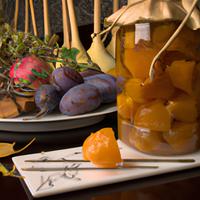
1 serving (20 grams) contains 56 calories, 0.0 grams of protein, 0.0 grams of fat, and 14.0 grams of carbohydrates.

Log this food in SnapCalorie

Nutrition Information
Calories |
666.7 | ||
|---|---|---|---|
% Daily Value* |
|||
| Total Fat | 0 g | 0% | |
| Saturated Fat | 0 g | 0% | |
| Polyunsaturated Fat | 0 g | ||
| Cholesterol | 0 mg | 0% | |
| Sodium | 59.5 mg | 2% | |
| Total Carbohydrates | 166.7 g | 60% | |
| Dietary Fiber | 2.4 g | 8% | |
| Sugars | 154.8 g | ||
| protein | 0 g | 0% | |
| Vitamin D | 0 mcg | 0% | |
| Calcium | 35.7 mg | 2% | |
| Iron | 1.2 mg | 6% | |
| Potassium | 238.1 mg | 5% | |
* Percent Daily Values are based on a 2,000 calorie diet. Your daily values may be higher or lower depending on your calorie needs.
Food Attributes
Source of Calories
About Fruit preserve
Fruit preserve is a sweet spread made by cooking fruits with sugar and, often, pectin to achieve a thick, jam-like consistency. Traditionally, it has roots in European cuisine, particularly as a way to extend the shelf life of seasonal fruits. Common varieties include strawberry, raspberry, and apricot preserves, though nearly any fruit can be used. While fruit preserves provide a concentrated source of vitamins, minerals, and antioxidants from the fruit, their nutritional profile can vary depending on the sugar content. Commercial versions often contain added sugars, which increase calories and may contribute to health concerns like weight gain or elevated blood sugar levels if consumed excessively. Opting for homemade or reduced-sugar options can be a healthier choice. Fruit preserves are versatile, enhancing breakfast foods like toast or yogurt, and they can also add flavor to baked goods and savory dishes.



